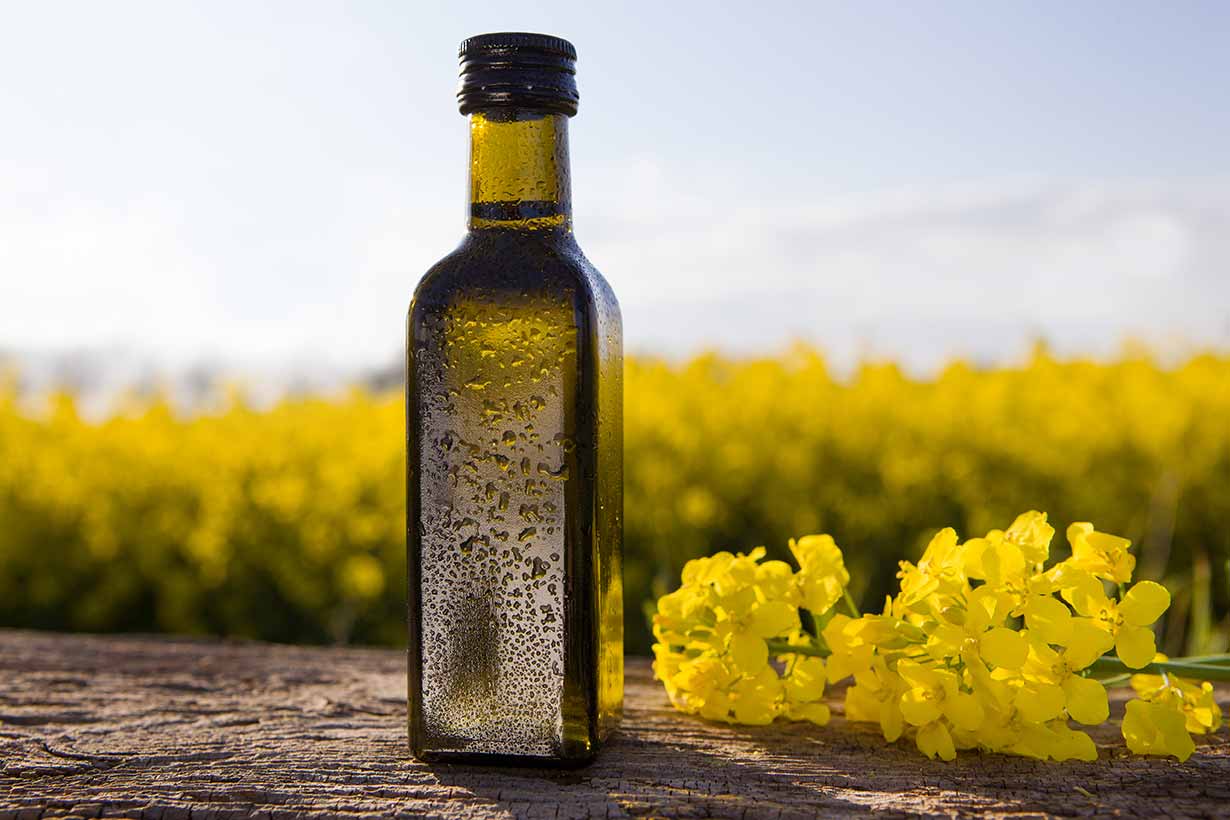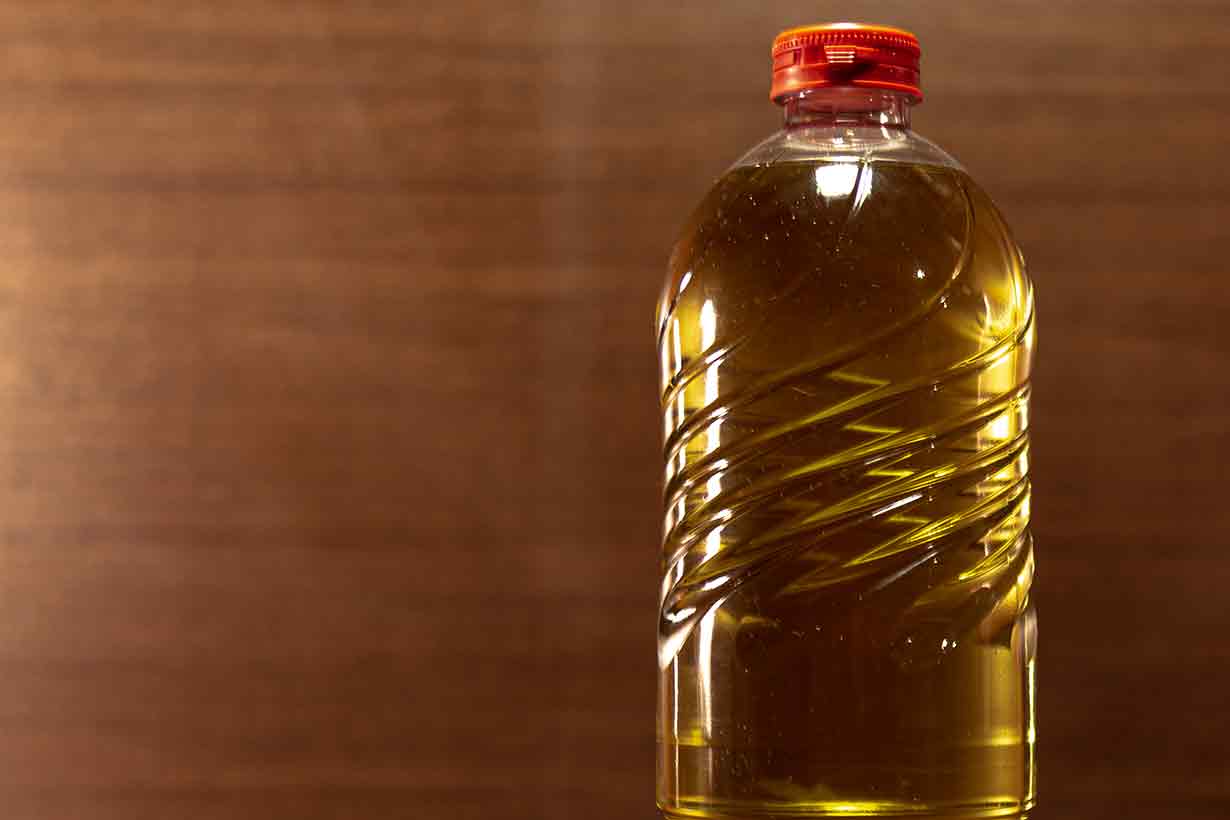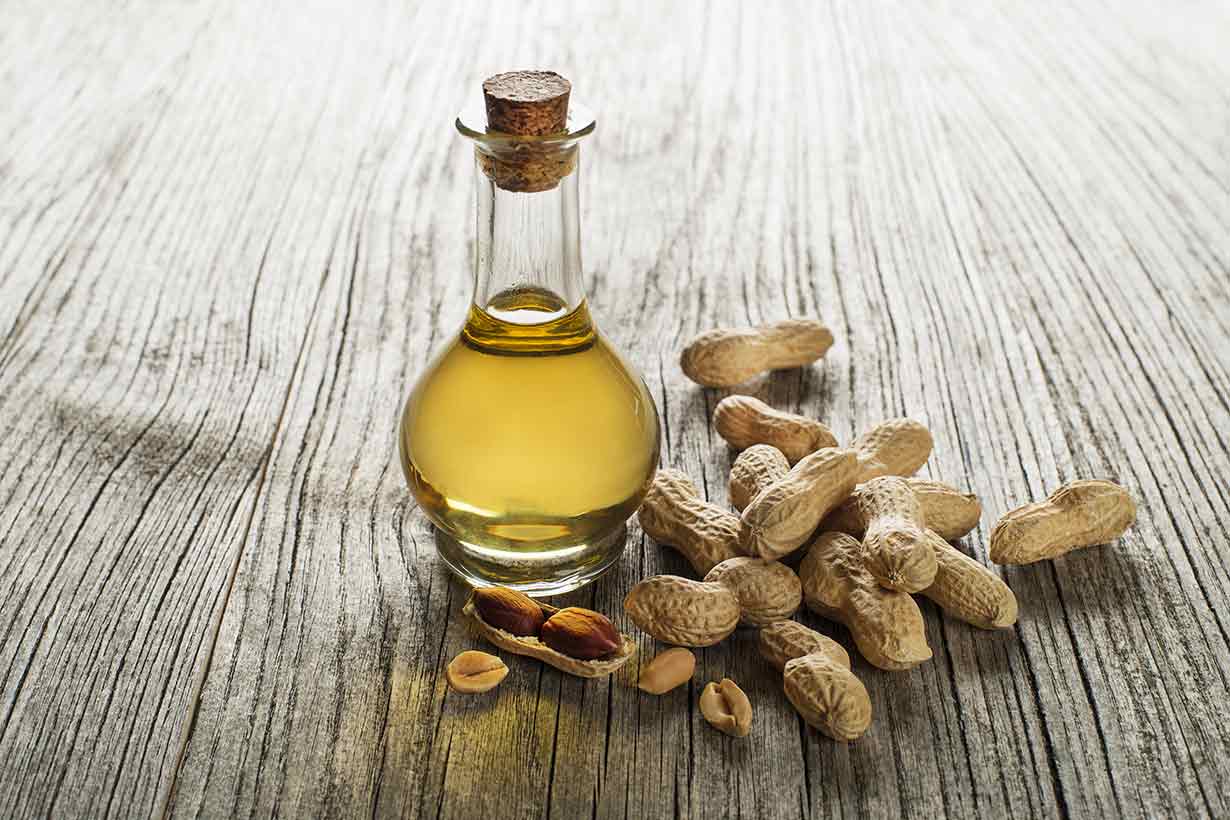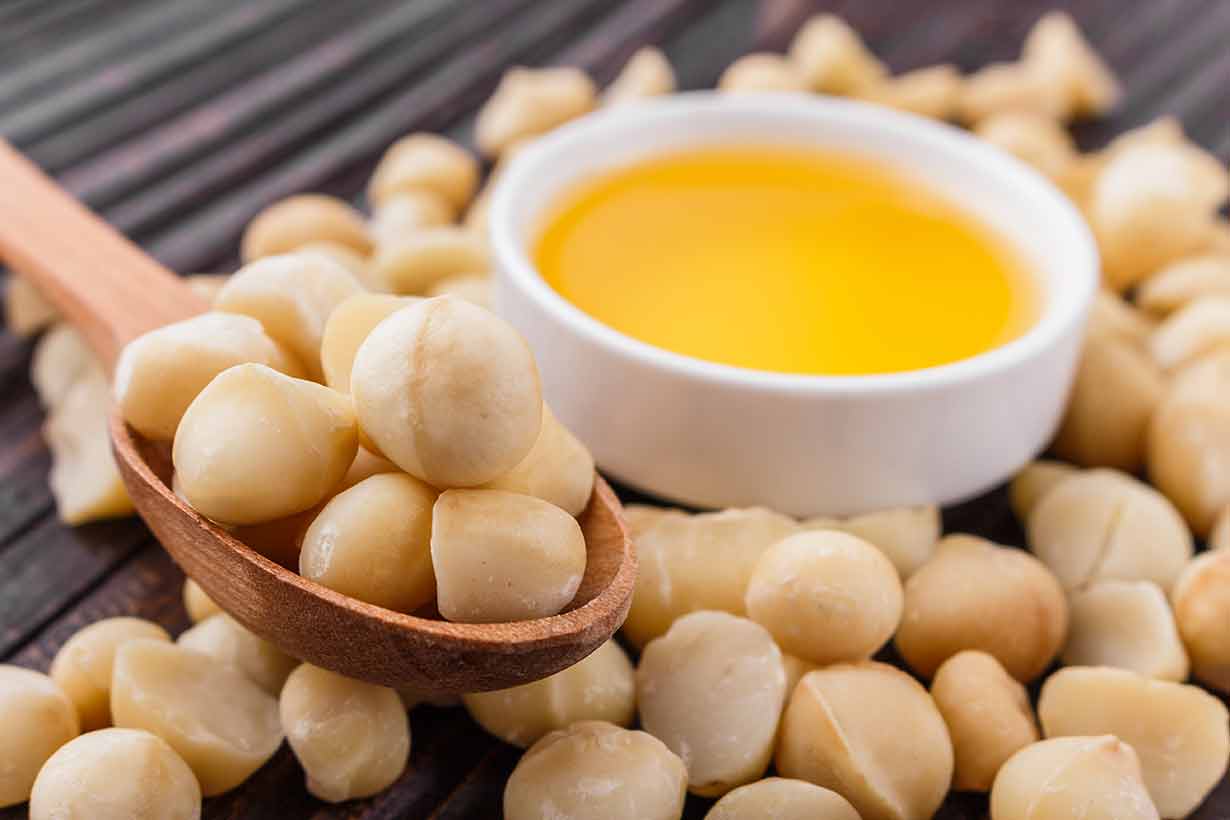There are many different cooking fats we can use, but which are the best oils specifically for deep frying?
This article presents a guide to the best fat for deep frying, as well as some important considerations to take into account.
As part of the guide, we’ll list eight different cooking fats known for their high-heat stability.
We’ll then rate each one based on its suitability for deep frying, considering various key factors.
Table of contents
Key Factors To Consider About Deep-Frying Fats
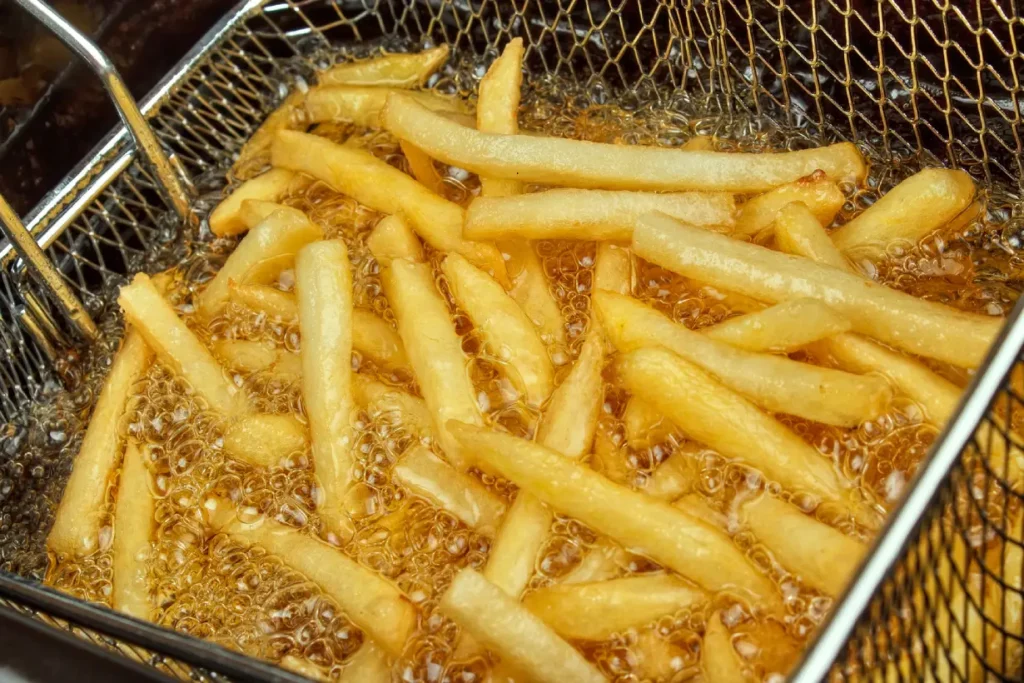
We will rate each oil’s suitability for deep frying by considering how it performs in regard to five key factors.
We should consider these key factors when choosing a deep-frying oil, and they include smoke point, flavor, degree of saturation, oxidative stability, and affordability.
Before we move on, let’s learn a little more about each of these factors.
1. Smoke Point
Smoke point refers to the temperature at which an oil breaks down and starts to burn.
Cooking fats with a low smoke point are less suitable for deep frying since this method of cooking typically involves high-heat temperatures.
2. Flavor
Most people prefer an oil with a neutral flavor for deep-frying food.
Cooking fats with a strong flavor, such as unrefined red palm oil, are unlikely to be a popular choice.
3. Degree of Saturation
Saturated fats are typically more heat-stable than polyunsaturated fats. This is because, unlike polyunsaturated fats, they contain no double bonds in their structure, which makes them less likely to react with oxygen and oxidize (1).
Polyunsaturated fats are more likely to react with oxygen when heated and break down into potentially harmful oxidation products (2).
However, diets high in saturated fats can lead to elevations in LDL cholesterol (LDL-C), which are strongly associated with an increased risk of cardiovascular disease (3, 4, 5). Therefore, this is a topic that requires nuance.
Monounsaturated fats sit somewhere in between; they aren’t quite as heat-stable as saturated fats, but they have better heat stability than polyunsaturated fats. Monounsaturated fats contain one double bond rather than multiple double bonds like polyunsaturated fat (6).
4. Oxidative Stability
Oxidative stability refers to a cooking fat’s stability at high heat temperatures and how resistant it is to oxidation.
While oxidative stability largely relates to the cooking fat’s degree of saturation, other factors are also involved.
For example, the presence of antioxidants, such as vitamin E, as well as polyphenols, can help boost an oil’s oxidative resistance (7, 8).
5. Affordability
Some fats may have good heat stability but an expensive price. Depending on the usage requirements, using oils with a high price tag for deep frying could be cost-prohibitive.
As a clear example, extra virgin olive oil displays excellent heat stability (9), but it would be very expensive to fill a deep fryer with it.
Deep-Frying Fats With High Oxidative Stability
Let’s now move on and examine some fats that have high heat stability.
For each option, we will consider its potential benefits and negatives in relation to the previously mentioned key factors.
Avocado Oil (Refined)
Avocado oil is the oil pressed from fresh avocado flesh.
This oil is naturally high in monounsaturated fat, with relatively low levels of saturated and polyunsaturated fat. This makes it a suitable option for individuals trying to lower their LDL.
Per 100 grams, avocado oil supplies 11.6 grams of saturated fat, 70.6 grams of monounsaturated fat, and 13.5 grams of polyunsaturated fat (10).
The predominant fatty acid in avocado oil is oleic acid, a type of monounsaturated fat known for its oxidative stability at high heat. In fact, it has been estimated that oleic acid is approximately 10-40 times “less susceptible to oxidation than linoleic acid”, which is a polyunsaturated fat (11).
Refined avocado oil has a smoke point of 271°C (520°F) (12).
A 2012 study found that avocado oil was relatively heat stable over several hours and had oxidative stability similar to olive oil (13).
On the downside, due to the cost of avocados, refined avocado oil tends to be relatively expensive, costing more than the other oils featured in this guide.
Overall rating: 5/10. Avocado oil has a lot of positive points, but its relatively high expense makes it difficult to justify as a deep-frying oil, bringing its score down.
Beef Tallow
Beef tallow is rendered animal fat from cows.
It is primarily a source of saturated and monounsaturated fat, with very little polyunsaturated fat.
Per 100 grams, it supplies 49.8 grams of saturated fat, 41.8 grams of monounsaturated fat, and 4 grams of polyunsaturated fat (14).
It has a smoke point thought to be around 250°C (480°F) (12).
Beef tallow is typically slightly more expensive than vegetable oils but cheaper than oils like extra virgin olive oil and dairy fats like ghee.
The fatty acid profile and smoke point of beef tallow make it suitable as a deep-frying oil. However, its saturated fat content may make it unsuitable for individuals attempting to lower their LDL cholesterol levels.
Overall rating: 5/10. Beef tallow displays good oxidative stability, has a high smoke point, and is relatively affordable. However, it is high in saturated fat, which might make it unsuitable for some individuals. Additionally, it makes the food unsuitable for vegetarians.
Coconut Oil (Refined)
Coconut oil is extracted from the meat of coconuts.
While extra virgin coconut oil has strong flavor notes, refined coconut oil has a neutral flavor better suited to deep frying.
Refined coconut oil has a smoke point of 204°C (400°F) (12).
The fatty acid composition per 100 grams is 82.5 grams saturated fat, 6.33 grams monounsaturated fat, and 1.7 grams polyunsaturated fat (15).
This high saturated fat content makes the oil highly resistant to oxidation. In one study, coconut oil outperformed nine other commercial oils by generating the lowest level of oxidation products over six hours of heating (16).
However, its high saturated fat content means coconut oil isn’t the best option for individuals monitoring their saturated fat intake.
Unlike extra virgin coconut oil, refined coconut oil is relatively less expensive. It is typically priced higher than most commercial vegetable oils but is cheaper than avocado and olive oil.
Overall rating: 6/10. Coconut oil is well-suited for high-heat cooking. However, its slightly higher price and high saturated fat content mean it isn’t the right choice for everyone.
Ghee
Ghee is pure butterfat that has been clarified to remove the milk sugars and proteins naturally present in butter.
It has a smoke point of approximately 250°C (482°F) (17).
Per 100 grams, ghee provides 61.9 grams of saturated fat, 28.7 grams of monounsaturated fat, and 3.7 grams of polyunsaturated fat (18).
This high degree of saturation gives ghee excellent oxidative stability.
However, as with other highly saturated fats, ghee can elevate LDL cholesterol levels (19).
Furthermore, ghee is expensive. It costs significantly more than butter and is often more expensive than avocado and extra virgin olive oils.
More information: The Differences Between Ghee and Butter
Overall rating: 4/10. While ghee displays good oxidative stability, it is extremely expensive for using as a deep-frying oil. Like other saturated fats, it can also raise LDL cholesterol levels.
High OLEIC Vegetable Oils
Most of the common commercial vegetable oils contain moderate to high levels of linoleic acid, a polyunsaturated fat. These oils include canola, safflower, soybean, and sunflower oils.
However, due to their relatively low oxidative stability, these oils are less suited for prolonged, high-heat deep-frying as they can oxidize quickly (20).
Due to this, high oleic varieties of these oils have been developed for better performance during high-heat cooking. These oils are high in the monounsaturated fat oleic acid, the primary fatty acid found in avocado and olive oil (21).
A systematic review demonstrated that using these oils instead of oils high in saturated fats significantly lowers LDL cholesterol (22).
Additionally, research shows that due to their high oleic acid content and relatively low levels of polyunsaturated fat, these high oleic oils have significantly improved oxidative stability compared to their counterparts high in polyunsaturated fat (23).
Per 100 grams, high oleic sunflower oil contains 9.86 grams of saturated fat, 83.7 grams of monounsaturated fat, and 3.8 grams of polyunsaturated fat (24).
Refined high oleic sunflower oil has a smoke point of 232°C (450°F) (12).
Although high oleic varieties of soybean and sunflower oil are more expensive than their regular counterparts, they are significantly cheaper than fats like avocado and olive oil.
Learn more: High Oleic Sunflower Oil: Nutrition Facts & Benefits
Overall rating: 8/10. High oleic oils, such as high oleic sunflower oil, provide good oxidative stability for a reasonable price and can lower LDL cholesterol compared to saturated fats.
Lard
Lard is rendered animal fat from pigs.
Solid at room temperature, lard provides high amounts of saturated and monounsaturated fat, with a smaller provision of polyunsaturated fat.
Per 100 grams, lard contains 39.2 grams of saturated fat, 45.1 grams of monounsaturated fat, and 11.2 grams of polyunsaturated fat (25).
Lard has a smoke point of 190°C (374°F) (12).
Given its high levels of saturated fat, lard has good oxidative stability. In one study, oxidative changes in cooking fats were measured while deep-frying French fries at 180°C (356°F).
The study determined that rapeseed (canola) oil oxidized 1.55 times faster than lard, and 1.72 times faster than coconut oil. In other words, coconut oil was the most stable of these three cooking fats, and lard displayed significantly better oxidative stability than rapeseed oil (26).
However, as with any highly saturated cooking fat, lard also has the potential for increasing LDL cholesterol.
Lard is typically cheaper than fats like avocado and olive oil, but it is more expensive than highly polyunsaturated vegetable oils like soybean and sunflower oil.
Overall rating: 5/10. Lard has good oxidative stability, yet it isn’t suitable for all due to its potential for increasing LDL cholesterol. Foods cooked with lard are also unsuitable for vegetarians.
Olive Oil (Refined)
First, it is important to note that both refined olive oil and extra virgin olive oil are excellent options when it comes to oxidative stability (27).
Extra virgin olive oil has low levels of polyunsaturated fat and is also rich in polyphenols, and both these attributes contribute to its stability (28).
Learn more: Cooking With Extra Virgin Olive Oil: Good or Bad?
However, extra virgin olive oil is significantly more expensive than refined olive oil—and most other cooking fats—making it an unlikely choice for deep frying. Refined olive oil also has the benefit of having a more neutral flavor.
Per 100 grams, refined olive oil provides 15.52 grams of saturated fat, 68.4 grams of monounsaturated fat, and 9.5 grams of polyunsaturated fat (29).
In a 2018 study, during prolonged high-heat exposure, olive oil generated fewer oxidation products than all other cooking oils except virgin olive oil and coconut oil. Some of the oils in this comparison included avocado oil, canola oil, and peanut oil (16).
Refined olive oil has a smoke point that ranges from 199–243°C (390–470°F) (12).
Refined olive oil is priced at levels slightly above oils like high oleic sunflower oil, but it is cheaper than avocado and extra virgin olive oil.
Overall rating: 7/10. Refined olive oil provides good oxidative stability, a moderate price, and it is relatively low in saturated fat. However, it’s still quite expensive for a deep-frying oil and costs more than high oleic oils.
Peanut Oil (Refined)
Peanut oil is a popular frying oil, which has become more well known with the global expansion of the popular fast food chain Five Guys.
Food fried in peanut oil provides a pleasant taste, and the oil is primarily a source of monounsaturated fat.
Per 100 grams, peanut oil contains 16.2 grams of saturated fat, 57.1 grams of monounsaturated fat, and 19.9 grams of polyunsaturated fat (30).
Since refined peanut oil is relatively low in polyunsaturated fat, it offers moderately good oxidative stability. However, a study has demonstrated that prolonged cooking at high temperatures with peanut oil generates more oxidation products than avocado, olive, and coconut oil (16).
High oleic peanut oil is also available, and it displays significantly higher oxidative stability (31). Yet it also commands a higher price, typically costing more than other high oleic oils.
Peanut oil has a smoke point of 232°C (450°F) (12).
Overall rating: 7/10. Peanut oil isn’t quite as heat stable as olive oil, but it costs slightly less. It also offers better oxidative stability than cheaper vegetable oils.
The Best Deep-Frying Oil
For deep frying at high heat temperatures, we believe high oleic oils such as high oleic sunflower oil or high oleic soybean oil are the best choice.
This is based on the characteristics and performance of high oleic oils across smoke point, flavor, affordability, oxidative stability, and degree of saturation.
Important Considerations and Caveats
Here are some caveats and further considerations to understand about deep frying.
Deep Frying Will Never Be the Healthiest Cooking Method
It is okay to consume deep-fried food from time to time, but it shouldn’t really play a habitual role in our diet.
Although we can try to make it healthier, deep frying is far from the best cooking method for general health and nutrition purposes. This is largely because deep-fried food tends to contain high amounts of fat and overall calories.
It is also true that cooking at high heat over long durations will generate some degree of oxidation products, no matter what cooking fat we use (32).
Gentler cooking methods, such as baking, boiling, poaching, and steaming, are generally viewed as healthier options.
Large scientific reviews and observational studies show that frequent consumption of deep-fried food is associated with an increased risk of certain types of cancer, obesity, and cardiovascular disease (33, 34, 35, 36, 37, 38).
However, the exact reasons for this—whether calorie intake, oxidized oils, overall dietary pattern, or other factors—is largely unknown.
The Best Oil For Deep-Frying Isn’t Necessarily the Healthiest Oil Overall
This article is solely focused on the best oils for deep frying, largely based on their oxidative stability, affordability, and considerations regarding their saturation.
However, this doesn’t mean that they are the healthiest or “best” oil in general.
For example, extra virgin olive oil is consistently associated with health benefits, but it is too expensive to realistically use for deep frying.
Additionally, the oil choice for deep frying probably doesn’t matter too much if its just for a very occasional meal and a short cooking time.
The oil choice becomes more important for frequent deep frying at high temperatures for prolonged periods of time.
For more information on cooking oils, see this guide to the nutritional properties of different oils.


